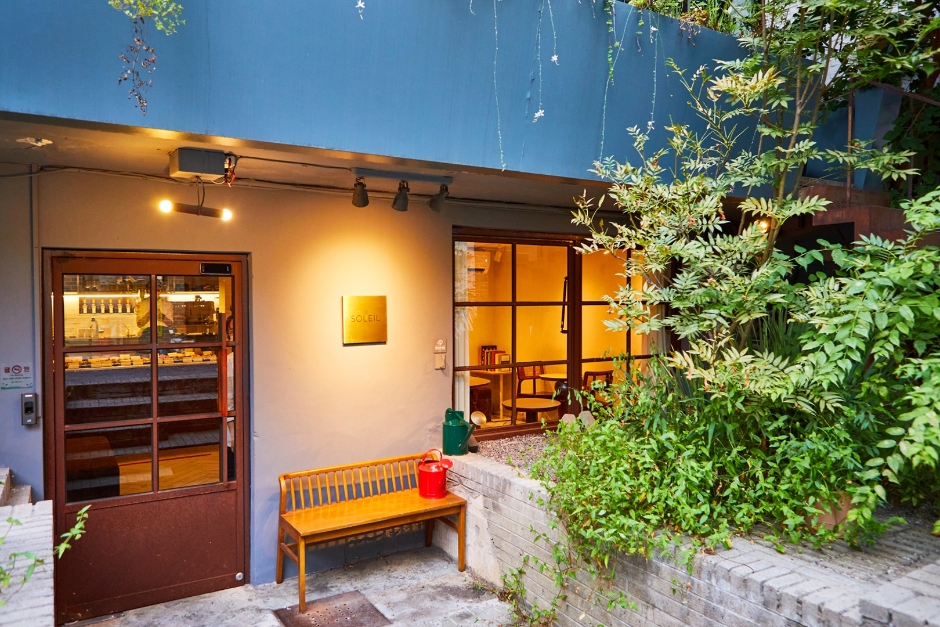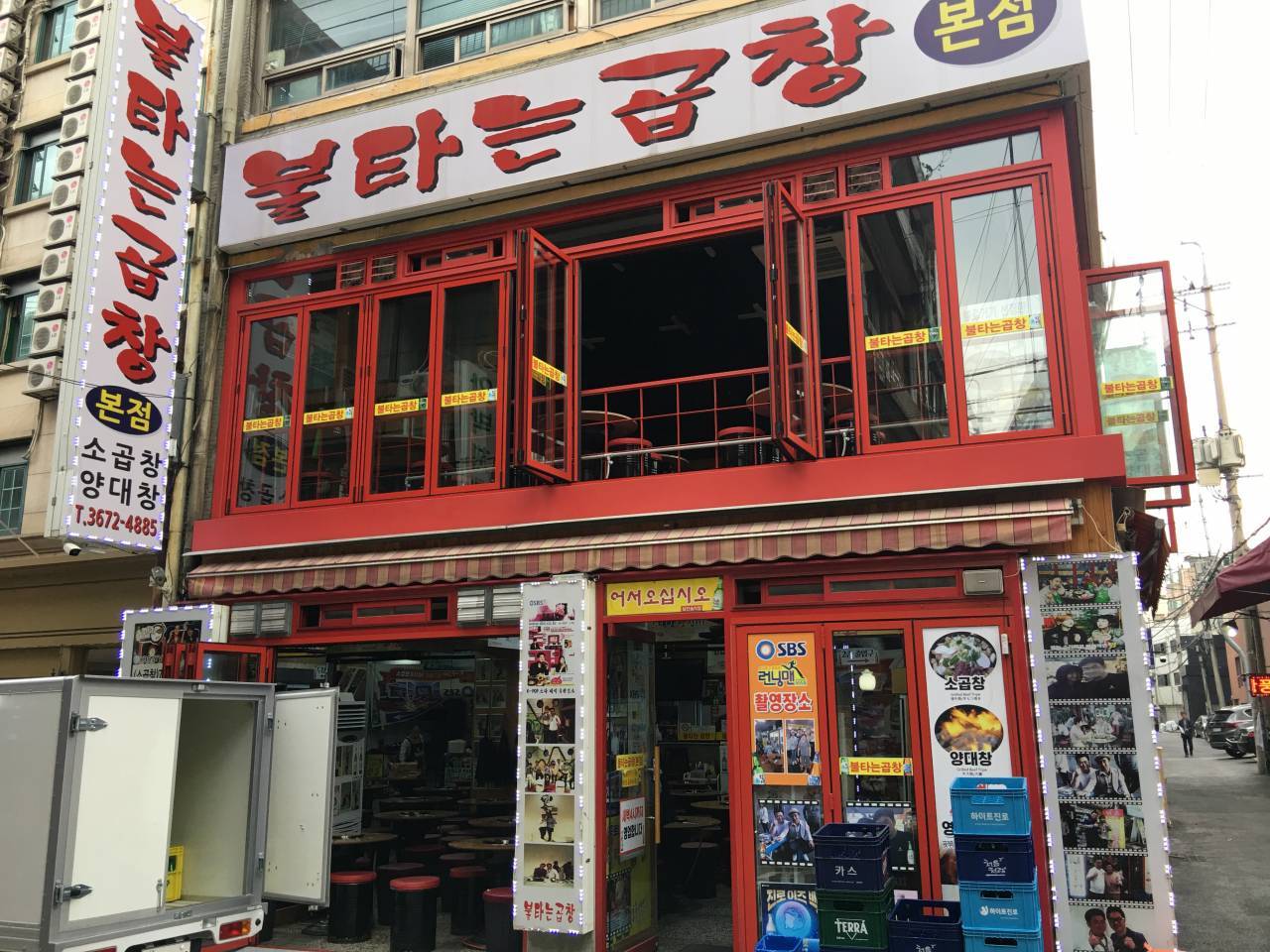LE SOLEIL (르솔레이)
3.2Km 2024-03-18
28 Itaewon-ro 54-gil, Yongsan-gu, Seoul
LE SOLEIL is a dessert café in Yeonhui-dong that is small but constantly crowded with customers. About 20 kinds of madeleines of various ingredients fill the showcase. Representative menu items include Rose & Litchi Madeleine, which has a subtle rose scent and attractive litchi flesh, and Nurung Madeleine, which combines cream cheese and scorched rice toppings. Brûlée Madeleines with a luxurious vanilla scent and Truffle Madeleines with a truffle scent are also popular because they are not commonly seen elsewhere. Popular items will likely be sold out early, so it is best to check the information through their official Instagram before visiting.
Bultaneun Gopchang (불타는곱창)
3.2Km 2021-07-20
8, Jong-ro 35-gil, Jongno-gu, Seoul
+82-2-3672-4885
This Korean cuisine is located near Jongno 5(o)ga Station, Seoul. The representative menu is assorted pork intestines/assorted beef intestines. A restaurant specializing in Korean-style grilled intestines.
Go-un [Korea Quality] 고운 [한국관광 품질인증]
3.2Km 2024-08-14
35-1, Bukchon-ro 12-gil, Jongno-gu, Seoul
+82-504-0904-2464
Go-un, meaning "High Cloud," is a hanok stay atop a steep hill in Gahoe-dong, Bukchon Hanok Village, Jeongno-gu, Seoul. The view from the house’s big windows takes in hanok tiled roofs, Seoul’s downtown, and Inwangsan Mountain - a vista that merges the past and the present. After enjoying Bukchon's attractions, entertainment, and food, guests can relax in the hanok’s half-body bath overlooking the yard (mugwort bath salts provided) - or enjoy a movie on the beam projector.
Queens Bucket - Dongdaemun Branch [Tax Refund Shop] (쿠엔즈버킷 동대문)
3.2Km 2024-04-18
5-4, Toegye-ro 64-gil, Jung-gu, Seoul
-
Lagidang [Korea Quality] / 락이당 [한국관광 품질인증]
3.2Km 2024-08-27
121, Gyedong-gil, Jongno-gu, Seoul
+82-507-1358-3701
Lagidang is a foreigner-only guesthouse in the heart of Bukchon Hanok Village in Jeongno-gu, Seoul. Public transportation links are good, with Exit 3 of Anguk Subway Station just a seven-minute walk away. The house has a fine view over Bukchon Hanok Village, and early-rising guests will also catch the sunrise in the south-eastern sky. The guesthouse is decorated with art works and Joseon-period antiques.
Goodmorning City (굿모닝시티)
3.2Km 2020-05-09
247, Jangchungdan-ro, Jung-gu, Seoul
+82-2-2118-8700
Opened in November 2008, Goodmorning City is one of the largest shopping malls in Korea. It is located near the Dongdaemun History & Culture Park Station and is directly linked to other shopping malls in Dongdaemun.
The mall is comprised of 23 floors and over 700 stores, offering visitors virtually every kind of product—from fashion accessories to electronics. With a variety of stores and amenities, Goodmorning City is truly a comprehensive shopping mall that provides visitors with an amazing shopping and entertainment experience.
Bonafide Jewelry [Tax Refund Shop] (보나파이드주얼리)
3.2Km 2024-06-27
29, Itaewon-ro 54ga-gil, Yongsan-gu, Seoul
-
ABC-Mart - Sinchon Branch [Tax Refund Shop] (ABC마트 GS신촌점)
3.2Km 2024-04-22
6, Myeongmul-gil, Seodaemun-gu, Seoul
-
Olive Young - Yaksu Station Branch [Tax Refund Shop] (올리브영 약수역)
3.2Km 2024-04-22
189, Dongho-ro, Jung-gu, Seoul
-
Inwoohouse [Korea Quality] / 인우하우스 [한국관광 품질인증]
3.2Km 2023-09-12
1-9 , Gyedong 6-gil, Jongno-gu, Seoul
+82-2-742-1115
Inwoo House is a traditional hanok down an alley in Gye-dong, Jongno, Seoul. There is a swallow's nest under the eaves, and the pride of this house is that the swallow family returns every spring. Each room in the house has a private bathroom. Residents can sample Korean culture by taking part in traditional paper crafts, knot bracelet making, and fan decorating. The location is convenient for restaurants, cafes, and convenience stores, and Gyeongbokgung Palace, Changdeokgung Palace, Insadong, and Samcheong-dong are all within walking distance.


![Queens Bucket - Dongdaemun Branch [Tax Refund Shop] (쿠엔즈버킷 동대문)](http://tong.visitkorea.or.kr/cms/resource/47/2878747_image2_1.jpg)


![Bonafide Jewelry [Tax Refund Shop] (보나파이드주얼리)](http://tong.visitkorea.or.kr/cms/resource/37/3314337_image2_1.jpg)
![ABC-Mart - Sinchon Branch [Tax Refund Shop] (ABC마트 GS신촌점)](http://tong.visitkorea.or.kr/cms/resource/95/2890495_image2_1.jpg)
![Olive Young - Yaksu Station Branch [Tax Refund Shop] (올리브영 약수역)](http://tong.visitkorea.or.kr/cms/resource/83/2889583_image2_1.jpg)
![Inwoohouse [Korea Quality] / 인우하우스 [한국관광 품질인증]](http://tong.visitkorea.or.kr/cms/resource/56/3009456_image2_1.jpg)
 English
English
 한국어
한국어 日本語
日本語 中文(简体)
中文(简体) Deutsch
Deutsch Français
Français Español
Español Русский
Русский